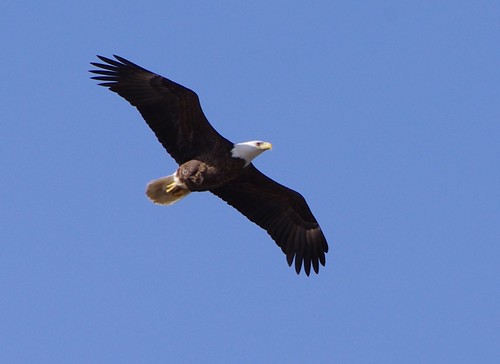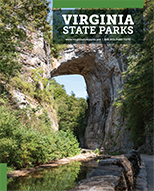Read Our Blogs
A Day in the Life of York River State Park: Eagle Spotting
From March until September, Bald Eagles and Osprey maintain a great rivalry along the York River and the Chesapeake Bay region.
Eagles have a notorious habit of stealing fish from the smaller fish hawks. However, osprey are fearless in defending their young and will fight off any larger bird away from a nesting platform. As the leaves start to turn color, osprey migrate southward to enjoy fall and winter in the tropics. Their absence leaves the bald eagle to be the uncontested master of the waterways.

This Bald Eagle keeps watch over fossil beach
While York River State Park does not boast the numbers of these great birds as Caledon or Mason Neck, paddlers and hikers do spot them frequently. We are not far away from Chickahominy and Hog Island Wildlife Management Areas and their healthy populations of these birds. Thus a few nesting pairs from these areas have taken up residence along our 2,550 acres and 4 miles of river shoreline.

The eagle has a 6 to 8 foot wingspan
Bald eagles can be found almost anywhere at any time at the park. Some years ago, wildlife biologist found a nesting pair near Croaker Landing. Aiming your binoculars and spotting scopes at the treetops along the shoreline is a good way to find them. They also tend to perch on the channel markers across from the boat ramp.

A juvenile bald eagle do not get the white head and tail until their third or fourth year
At the main section of the park, eagles tend to perch in the dead trees at the confluence of Taskinas Creek and the York. This provides the birds with a great view of what is swimming in a relatively shallow area. To see an eagle or two in the air at the Taskinas Creek Overlook adds to the drama of this scenic view.

We have an overlook on the Taskinas Creek Trail dedicated to Bald Eagles
Bald eagles will make similar use of the trees on the cliffs at fossil beach. Legend has it that a group of elementary school kids saw one of these impressive birds snatch a fish from the grasp of a river otter that was floating on its back enjoying its hard won meal. Not all eagle sightings are impressive as they will resort to stealing food from other predators, eating carrion, and feeding alongside vultures. A guest from the Pacific Northwest told me of his disdain for bald eagles as he saw them regularly raiding the dumpsters at fast food restaurants.

Cruising over the river
Yet to see this great bird in flight is to behold the results of nature rebounding from the brink of a great loss. DDT and other chemicals entered into the food chain and caused eagle and osprey eggs to become very fragile and break as parent birds sat on them to incubate them. These chemicals have been discontinued for decades, allowing wildlife management agencies and organizations to help the birds make a tremendous comeback.
For the best chance to spot our nation's symbol perched, in flight, or hunting, stay near the water. They are just as active on overcast days as they are in fair weather. Shutterbugs will want to use a point-and-shoot camera with a powerful zoom (12x and above). If you don't have a 400mm prime lens or better, be patient and keep a sharp eye out for these birds. Bald eagle images can be difficult to capture with a 200mm or 300mm lens. But when you get one, it will be one of the greatest rewards you can find in outdoor photography. Even without a camera, it is hard not to admire their power and grace.

Eagles can be found between the river and Woodstock Pond
Directions to York River State Park: From I-64, take the Croaker Exit 231B. Go north on Route 607 (Croaker Rd.) for one mile, then right on Route 606 (Riverview Rd.) about one and a half miles to the park entrance. Take a left turn into the park.
If you have read the article and have a question, please email nancy.heltman@dcr.virginia.gov.














